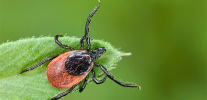
Ixodid ticks (Ixodidae) - one of the most famous families of the subclass Ticks (Acari). They are found on all continents and live within almost all distinguished climatic zones. Ixodides live even outside the polar circle, which indicates their high fitness and ability to survive in extreme conditions.
The greatest species diversity of ticks is characteristic, first of all, of the forests of the tropics and subtropics (due to the relatively high level of humidity, the complex longline composition of vegetation and the wealth of possible hosts).
However, areas with a temperate climate are also characterized by a rich species composition of these parasites, and Russia is no exception. Within our country, hundreds of species of blood-sicking parasitic ticks live: they are found everywhere - from taiga to arid semi-deserts.Blood suckers perfectly mastered all possible ecological niches and play a significant role in anthropogenic cenoses.
Moreover, ticks are common inhabitants of not only natural plant associations in nature, but also parks, squares, lawns and flower beds in cities. Such a neighborhood is dangerous for humans, since these parasites are carriers of a number of causative agents of severe natural focal diseases, such as tick-borne encephalitis, borreliosis (Lyme disease), typhus, etc.
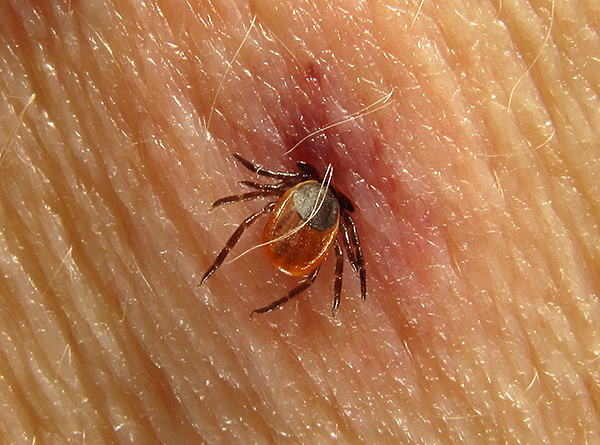
About where exactly and in what months of the year the risk to meet with ticks is greatest, we'll talk further ...
Where are ixodic mites
Ticks are concentrated where there are necessary microclimatic indicators and their potential hosts live. Within the main natural zones, these bloodsuckers are distributed in a mosaic pattern, and can often form massive clusters of numbers.
It should be borne in mind that ticks migrate slightly in the horizontal direction - they take a wait-and-see attitude, and resort to active pursuit only in exceptional cases.
Actually, all the movement of these parasites is connected with the search for the future owner, therefore, the spatial distribution of parasites fully corresponds to the places of movement, life and shelters of small and large mammals, birds and reptiles.
Below the photo clearly visible ticks in birds around the eyes:
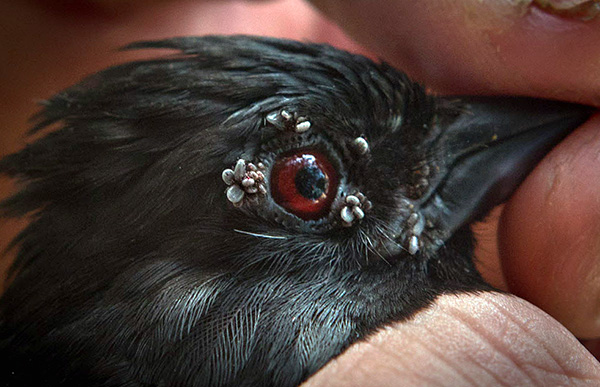
And here - the parasite stuck to the head of a rodent:
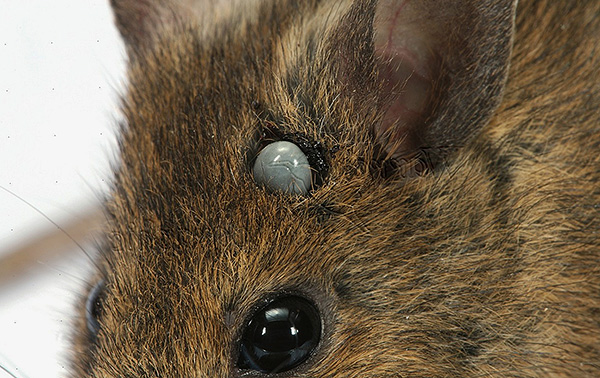
Thus, the main habitats of ticks are:
- forest trails;
- well warmed and moistened forest edges and forest glades;
- pastures;
- parks and squares in cities, lawns;
- gardens, gardens in the country, which are often visited by pets and people.
The microclimate in one location or another has a key influence on the vital activity and activity of ticks - for them it is a decisive factor in the passage of ontogenesis, most of which they live as free-living organisms. Even if the tick, before feeding, lived in suitable conditions, having fallen off after the blood sucking from the host at an unfavorable station, the parasite dies.
Therefore, this group of species has developed special adaptations to counteract the harmful effects of the environment. These counteractions are expressed in the choice of habitats, and two groups of ticks are distinguished here:
- pasture bloodsuckers;
- burrowing bloodsuckers.
Pasture and burrowing bloodsuckers
In search of the best microclimatic conditions, some types of ticks went in a simplified way and settled in the burrows of their hosts, where there is always quite warm, humid and there is food. Other species have adapted to life in forests and in open spaces.
The most striking example of a pasture parasite is a dog tick (Ixodes ricinus) - one of the most common in Russia and in the Moscow region, in particular. It lives, first of all, in rather wet types of forests (mixed and deciduous), preferring to be in dry leaf litter, as well as among lush vegetation.
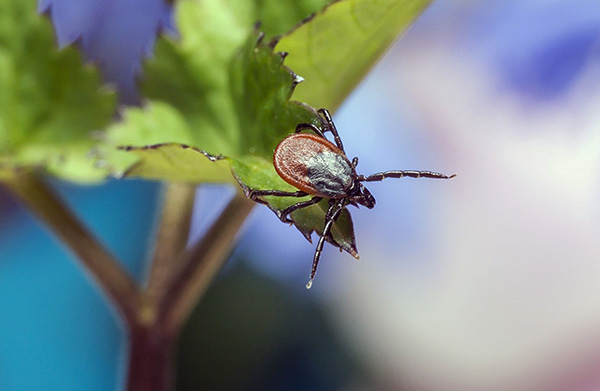
On a note
The name “dog” does not mean that the parasite feeds only on dogs - almost all mammals, as well as birds, frogs and lizards, can become its victims.
In highly wetlands, in a swampy area and peatlands, a dog tick is not found. Similarly, these parasites avoid being in dry, purely coniferous forests. That is, the decisive factor in this case is humidity.
On a note
With a lack of water in the body, mites descend on wet substrates and absorb moisture from the whole body.
It is a common misconception that mites fall from trees and shrubs.In fact, they do not climb trees, but are located exclusively in the grassy tier. Therefore, the greatest danger is precisely the juicy, tall grass in places of frequent movement of animals and people.
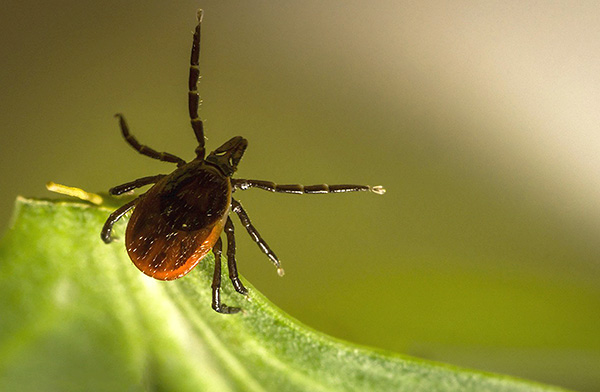
As for burrow mites, they live almost exclusively in the burrows and nests of their owners, and for this reason they usually do not pose a danger to humans. These include, first of all, Argass mites, less often similar species are found among the Ixodes.
A striking example of a nervous parasitism among ixodides is the parasite of a swallow-beregovushka that lives in the nests of these birds. The bloodsucker is a highly specialized species, and feeds exclusively on the blood of the swallows. Accordingly, in the life cycles of the parasite and the host, there is a maximum correlation: the adult stage of the bird corresponds to the imago mite, and the timing of hatching of chicks corresponds to the appearance of larvae and nymphs.
Thus, it is the grazing free-living mites that are the carriers of many infections that pose the greatest danger to humans and domestic animals.
The life cycle of parasites
The life cycles of ticks are quite complex, which is associated with the peculiarities of metamorphosis and the need to search for and change hosts. At the same time, the vital activity of the same species significantly differs within different natural zones, and directly depends on the microclimatic indicators of habitats. The rhythms of life cycles entirely depend on the seasonal dynamics of abiotic factors, such as the duration of the daylight hours, humidity, temperature, etc.
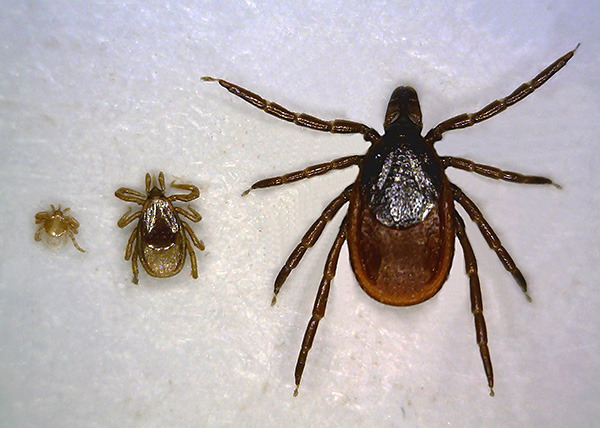
On a note
The most primitive are continuous cycles in which synchronization with seasonal rhythms is minimized. This type of ontogenesis is characteristic of species living in a warm and humid tropical climate or in the burrows of animals and birds, where fluctuations in microclimatic indicators are insignificant.
The most complex cycles are characteristic of ticks, which need special adaptations in order to survive adverse environmental conditions (first of all, winter temperatures).
The longest and most complex development cycles are characteristic of the taiga and forest European mites, whose ranges have shifted far to the north, much further than the ranges of other species.Normally, for the full development of each stage of ontogenesis, it takes about 1 year, therefore the minimum period of development from egg to adult is 3 years, and the maximum - 6 years.
Adults, mostly adults and hungry females, attack large mammals and humans in April-May, with the peak of aggressiveness occurring precisely in the second decade of May. At this time they are waiting for their prey in the high grass on pastures, near ponds, forest paths, parks and squares in cities.
If the female succeeds in sucking successfully, then nutrition begins, which lasts for several days., after which the tick disappears, and after about 2-3 weeks starts laying eggs. Parasite eggs are laid in about the same places where separation from the host occurred. For these bloodsuckers in general, it is not typical to create any nesting structures or to care for offspring.

On a note
Often the eggs are attached to the grassy vegetation, less often the female lays them directly on the animal's hair - then the hatched larvae will not need to look for a host.
In the summer, larvae hatch from eggs laid, which feed on small rodents and birds.They have tiny sizes and only 3 pairs of limbs, therefore they are sometimes confused with insects.
The photo below shows the mite larvae:

After feeding, the larvae are looking for a place to winter: mostly they choose leaf litter and indentations in the bark of trees. There, in a state of diapause, small bloodsuckers wait out the winter. If the larva does not have time to feed before the onset of cold weather, it dies.
Sometimes the larvae have time to molt in the nymphs before winter, but often also molt occurs only after exiting diapause. Each molt is accompanied by bloodsucking.
Tick nymphs differ from larvae in their larger size and the presence of another (fourth) pair of legs. They are able to feed on larger animals, such as dogs, cats, foxes, rabbits.
In the spring and summer-autumn period of the 3rd year from the beginning of the life cycle, adult individuals appear. They begin to eat immediately, or again go into diapause. Feeding is necessary for the female, first of all, for the maturation of the eggs, therefore it is extremely important that the mating occurs before feeding. Males, on the other hand, either do not feed at all, or feed for a very short time, since they perform only the function of inseminators.
Thus, the entire life cycle of ticks is associated with the search for the host and nutrition. The success of the parasite hunt directly depends on the choice of a suitable place of suction to the host body.
Tick bites and their danger to humans
The most common and widespread in the territory of Russia and the CIS countries, the common forest (dog) and taiga ticks carry a number of pathogens of extremely dangerous human diseases, such as:
- different forms of tick-borne encephalitis;
- tick-borne typhus;
- Lyme disease (borreliosis);
- tularemia and some others.
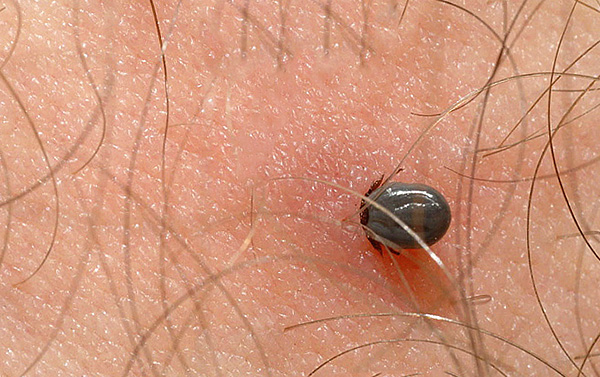
You can pick up a tick in a variety of places - from walking in the woods and ending with the city park. The parasite penetrates under clothing and sticks to the body, mainly in areas with thin, well-supplied blood. (favorite places for sucking are the neck, chest, behind the ears, and the ears, head, axillary and groin areas).
On a note
Ticks can also be brought into the house on clothes or shoes, on pet hair, with bouquets of wildflowers. Already in the house, the parasite can bite any member of the family, even after a considerable period of time.
A tick infects its host already during suction, when it injects saliva under the skin containing the causative agents of a particular infection. And the longer the tick is on the body, the more likely it is to get sick.
Symptoms of the disease do not appear immediately: the incubation period can last up to one month. In the case of tick-borne encephalitis, the progression of the disease can occur in different ways, but there are also general symptoms: a sharp increase in temperature, muscle and headaches often occurs. In the case of tick-borne borreliosis, a characteristic sign of infection is the appearance of the so-called migrating ring erythema - on the skin near the wound left after the tick bite, concentric rings of reddish, brown or yellow color are formed (an example is shown below).
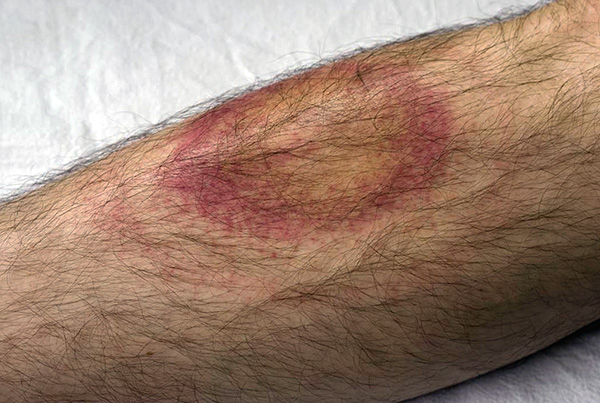
Prevention measures: how to protect yourself from the negative effects of contact with ticks
The best defense against ticks is to prevent their possible bites. It should be borne in mind that the tick bite is almost impossible to feel (the parasite contains anesthetic substances in the parasite's saliva). Also, not every person is able to feel how the tick moves through the body.

Since these parasites mostly sit in the grass, waiting for the victim, they mostly cling to the pants, then penetrate through the holes closer to the host’s body and crawl upwards in search of a favorable place. Therefore, when going out into the countryside, especially during the season of tick activity, it is advisable to wear closed, light-colored clothes, on which the parasite will be better visible - it will be easier to notice and remove from the clothes in time. Pants need to be tucked into socks so that the bloodsucker does not penetrate under them, and the shirt into the trousers. The cuff of the shirt should fit snugly against the body. The neck and head should also be covered.
On a note
For more reliable protection, recommended processing of clothes with proven repellents: these chemicals are specifically designed to protect against ticks.
However, what to do if the tick is still stuck? One should not panic - not all ticks (even in epidemiologically unfavorable regions) are infected pathogens of dangerous diseases. And even if the parasite is infected, not in every case a bite of it will lead to the development of a human disease.

Anyway, one should not relax either, since only correctly and in time taken measures will minimize the likelihood of undesirable consequences.
First you need to remove the tick. It is easy to do this yourself, using, for example, tweezers or special tools for extracting ticks.
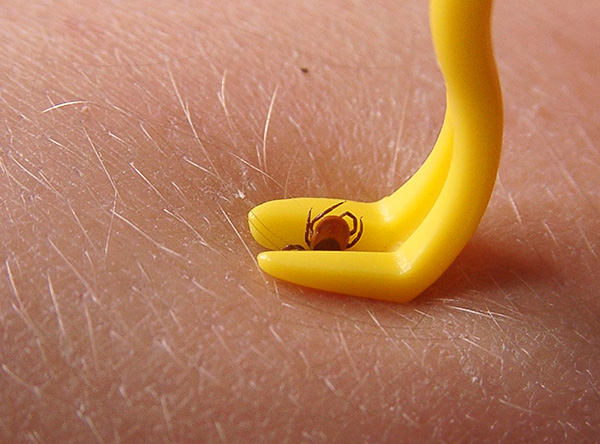
More information about the actions of the parasite bite is written in a separate article: First aid for tick bites
Generally speaking, there is nothing difficult in removing a sucking tick. The main thing - you can not pull out the parasite too sharply and put a lot of pressure on it with your fingers. First, the head of the tick can come off and remain in the wound, subsequently causing a strong suppuration. Secondly, when squeezed, the tick will release a large amount of saliva and already infected blood into the wound - accordingly, if the arthropod is infected, the concentration of pathogens in the wound will increase greatly.
After removing the tick, the wound must be disinfected (can be treated with alcohol, brilliant green, iodine or hydrogen peroxide). Wash hands thoroughly with soap and water. The extracted tick should be taken for analysis to make sure it is not infected, and if necessary take appropriate measures (for example, emergency prevention of tick-borne encephalitis consists of injections of gamma globulins).
Useful video about tick habitats and diseases transmitted by these parasites
How not to get into nature in places with the highest concentration of ticks and identify their accumulations in the grass

